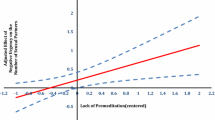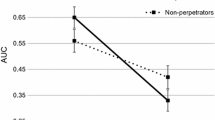Abstract
This study broadens our understanding of the role of impulsivity in Mexican adolescent sexuality by examining how impulsivity constructs (i.e., positive urgency, negative urgency, lack of premeditation, lack of perseverance, and sensation seeking) were associated with Mexican adolescent normative sexual behaviors and intentions. We also examined the role of gender and age in these associations. We administered measures of impulsivity, sexual intentions, and sexual behaviors to a sample of 563 Mexican adolescents, aged 12 to 16. The results indicated several associations between impulsivity and sexual outcomes. For instance, adolescents who exhibited lack of premeditation and lack of perseverance were more likely to expect to have sex (sexual intentions) and to engage in heavy petting. Age and gender moderated a few associations. Female adolescents (but not males) who reported more sensation seeking were more likely to expect to have sex (sexual intentions). Older adolescents (but not younger) who reported higher levels of positive urgency were more likely to engage in heavy petting. The current study expands the understanding of how a variety of impulsivity constructs are associated with the sexual intentions and behaviors of Mexican adolescents.


Similar content being viewed by others
References
Beadnell, B., Wilsdon, A., Wells, E. A., Morison, D. M., Gillmore, M. R., & Hoppe, M. (2007). Intrapersonal and interpersonal factors influencing adolescents’ decisions about having sex: A test of sufficiency of the theory of planned behavior1. Journal of Applied Social Psychology, 37(12), 2840–2876.
Cándido, A., Orduña, E., Perales, J. C., Verdejo-García, A., & Billieux, J. (2012). Validation of a short Spanish version of the UPPS-P impulsive behaviour scale. Trastornos Adictivos, 14(3), 73–78.
Cyders, M. A., & Smith, G. T. (2007). Mood-based rash action and its components: Positive and negative urgency. Personality and Individual Differences, 43(4), 839–850.
Dir, A. L., Coskunpinar, A., & Cyders, M. A. (2014). A meta-analytic review of the relationship between adolescent risky sexual behavior and impulsivity across gender, age, and race. Clinical Psychology Review, 34(7), 551–562. https://doi.org/10.1016/j.cpr.2014.08.004.
Donohew, L., Zimmerman, R., Cupp, P. S., Novak, S., Colon, S., & Abell, R. (2000). Sensation seeking, impulsive decision-making, and risky sex: Implications for risk-taking and design of interventions. Personality and Individual Differences, 28(6), 1079–1091. https://doi.org/10.1016/S0191-8869(99)00158-0.
Hipwell, A. E., Keenan, K., Loeber, R., & Battista, D. (2010). Early predictors of sexually intimate behaviors in an urban sample of young girls. Developmental psychology, 46(2), 366.
Kastner, R. M., & Sellbom, M. (2012). Hypersexuality in college students: The role of psychopathy. Personality and Individual Differences, 53(5), 644–649. https://doi.org/10.1016/j.paid.2012.05.005.
Killoren, S. E., Updegraff, K. A., & Christopher, F. S. (2011). Family and cultural correlates of Mexican-origin youths’ sexual intentions. Journal of Youth and Adolescence, 40(6), 707–718.
Steinberg, L. (2008). A social neuroscience perspective on adolescent risk-taking. Developmental review, 28(1), 78–106.
Tolman, D. L., & McClelland, S. I. (2011). Normative sexuality development in adolescence: A decade in review, 2000–2009. Journal of Research on Adolescence, 21, 242–255. https://doi.org/10.1111/j.1532-7795.2010.00726.x.
Whiteside, S. P., & Lynam, D. R. (2001). The five factor model and impulsivity: Using a structural model of personality to understand impulsivity. Personality and Individual Differences, 30(4), 669–689. https://doi.org/10.1016/S0191-8869(00)00064-7.
Zapolski, T. C., Cyders, M. A., & Smith, G. T. (2009). Positive urgency predicts illegal drug use and risky sexual behavior. Psychology of Addictive Behaviors, 23(2), 348.
Zimmer-Gembeck, M. J., & Helfand, M. (2008). Ten years of longitudinal research on US adolescent sexual behavior: Developmental correlates of sexual intercourse, and the importance of age, gender, and ethnic background. Developmental Review, 28(2), 153–224.
Funding
This study was funded by an internal grant: UNCW Cahill Award awarded to the first author (Graciela Espinosa-Hernandez).
Author information
Authors and Affiliations
Corresponding author
Ethics declarations
Conflict of interest
All authors declare that they have no conflict of interest.
Ethical Standards
We have complied with ethical standards in the treatment of our human participants. The study protocol has been reviewed and approved by The University of North Carolina Wilmington (UNCW) IRB Committee.
Ethical Approval
All procedures performed in studies involving human participants were in accordance with the ethical standards of the institutional research committee (UNCW) and with the 1964 Helsinki declaration and its later amendments or comparable ethical standards.
Informed Consent
Passive informed consent was obtained from all parents, and verbal assent was obtained from all individual participants included in the study.
Additional information
Publisher's Note
Springer Nature remains neutral with regard to jurisdictional claims in published maps and institutional affiliations.
An earlier version of this paper was presented at the 2017 Society for Research in Child Development Biennial Meeting at Austin, TX. We also want to thank Mrs. Zuilma Hernandez Montes De Oca, Mrs. Graciela Hernandez Coronel, and all the wonderful teachers and principals who made data collection possible.
Rights and permissions
About this article
Cite this article
Espinosa-Hernández, G., Mejia, A., Velazquez, E. et al. Impulsivity in Mexican Adolescent Sexuality. Sexuality & Culture 25, 1321–1333 (2021). https://doi.org/10.1007/s12119-021-09827-8
Accepted:
Published:
Issue Date:
DOI: https://doi.org/10.1007/s12119-021-09827-8




